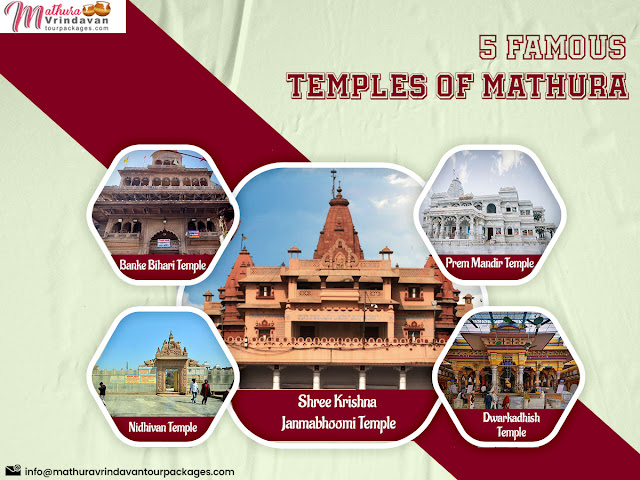The Fascinating Tales of Braj and Vrindavan Uncovered Through Interesting Facts
In the realm of religious tourism, few places draw more pilgrims throughout the year than the holy cities of Vrindavan and Braj. Vrindavan, named after the holy "bail" plant, is an ancient city that is the true reflection of the culture and traditions of ancient India. Beyond the gardens and ancient temples that make these pilgrimage centres stand out, there are numerous folk tales associated with various aspects of the cities. These holy tales are the reason why Vrindavan tour packages are the first choice among devotees and travel enthusiasts.
When touring the sacred region Braj with Mathura Vrindavan tour packages, these iconic sites are a must-visit for a genuinely divine experience. Whether you are a pilgrim or a curious tourist, this religious centre is bound to captivate you with its spiritual energy and provide you with a glimpse into the rich past of India.
Each corner of these places provides an unforgettable experience, with gardens, ghats, markets, and museums, each bearing exciting stories. Here are some interesting insights into the two pilgrimage sites that make Braj Bhoomi Yatra immensely exciting.
1. Govinda Deva Temple - Lost & Rediscovered
Vrindavan is home to the renowned Govinda Deva temple that draws thousands of devotees daily. However, not many people are aware that this ancient temple was lost and rediscovered in 1515 by the mystic Chaitanya Mahaprabhu. Using his magical abilities, he located the ruins of an ancient site believed to be the true location of what is now the well-known Govinda Deva temple.
2. The Mysterious Sounds of Ghungrus at Nidhi Van
Nidhi Van, popular as the sacred area where the Lord assumes a human avatar for Rasleela, continues to captivate devotees and locals of Vrindavan. According to legend, no humans are allowed inside Nidhi Van after sunset. The belief is that Lord Krishna and his companion Radha engage in their divine Rasleela at midnight. Locals claim to have heard the sounds of ghungrus, used in the Ras Leela, resonating amid the densely populated forest of Nidhi Van.
3. Ras Leela - The Holy Dance of Lord
According to local legends, after their Ras Leela, it is believed that the Lord and Radha rest in their abode at the Rang Mahal. Beds are decorated for both during the evening, and food and Prasad are left for the Lord. In the morning, the offerings are consumed, and the essentials are used to signify the presence of the Lord in the region post-midnight. No individuals are permitted to be in the vicinity of the Rang Mahal at night. Some tales also suggest that those who attempted to sneak into the Rang Mahal during the night have not survived. Whether a true legend or a matter of faith, the Rang Mahal surrounds endless mysteries of this holy town.
4. The Temple With No Shell
Ever thought about a temple without bells or conch shells? Well, the Bankey Bihari temple in Vrindavan is one of those unique places. Instead of bells and conch shells, people chant the His name during prayers and when distributing Prasad at sunrise and sunset. Legend has it that the Lord, in the form of Bankey Bihari, dislike the sound of conch shells.
5. Find the Footprints of Lord at Radha Damodar
The Radha Damodar Temple is a major draw. In this temple, you will find a rock that still stands today. Besides its age, there is something more interesting about this rock; it bears the footprints of Lord Krishna. It is said that the Lord appeared in human form to grant darshan to a devoted individual named Jiva Goswami. From ancient tales, you must be aware of the special connection between Lord Krishna and cows. Well, one can witness this connection on this rock as it also has preserved the hoof print of a cow.
6. Dance with Gopis inside Rangji Mandir
At the entrance of the biggest temple in Vrindavan, there is a detailed seven-story gateway, constructed in 1851 with a South Indian architectural touch. Inside, you will find a 50-ft wooden chariot on display and a gold-plated pillar called Dhwaja Stambha in the inner courtyard. The garden also has a seva kund, abundant with holy basil (tulsi) trees. At night, Krishna and Radha spend their time in the temple while gopis dance, and the atmosphere is illuminated with countless tulsi trees.
7. Defeat of Kesi at Kesi Ghat
According to legend, Krishna took a bath at this spot after defeating Kesi and celebrated His victory. Every evening, an aarti is performed for the Yamuna River at this sacred site.
Conclusion
The story of Braj and Vrindavan is filled with several interesting myths and legends. These facts offer a glimpse into the spiritual and cultural essence of this timeless land. Discover the simple yet profound tales that continue to shape the charm of Braj and Vrindavan.




Immerse yourself in the vibrant culture and spirituality of the mathura vrindavan tour, where mythology comes alive. Visit world-famous temples, enjoy the peaceful ghats, and explore traditional markets filled with colors and devotion. From Banke Bihari Temple’s divine darshan to Prem Mandir’s breathtaking architecture, each experience leaves you inspired. This tour is perfect for travelers seeking a blend of heritage, devotion, and cultural exploration in one of India’s most sacred destinations dedicated to Lord Krishna.
ReplyDelete